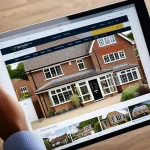Overview of Telemedicine in the UK
Telemedicine in the UK refers to the use of digital technology to provide healthcare services remotely. It allows patients and doctors to interact through virtual platforms, offering various benefits like enhanced patient care and increased access to specialists. Telemedicine has roots in efforts to improve healthcare delivery by integrating healthcare technology into the existing system.
Recent statistics indicate a substantial adoption of telemedicine across the UK. A recent report highlighted that teleconsultations now make up over half of GP appointments, showcasing significant growth in demand for remote health solutions. This shift is a testament to how healthcare technology is transforming patient interactions with healthcare professionals.
In parallel : What are the key factors influencing mental health awareness in the UK?
Key players in the UK telemedicine scene include established platforms like Babylon Health and Push Doctor, which have been instrumental in delivering widespread telemedicine services. These platforms enable patients to access consultations from the comfort of their homes, making healthcare more accessible, especially in remote areas where traditional healthcare services might be scarce.
Understanding the concept and current applications of telemedicine in the UK emphasises the evolving nature of healthcare. As the NHS continues to invest in digital solutions, patient care is poised for even more improvements, ensuring that healthcare technology remains a pivotal component of the healthcare system.
Also read : How is the UK integrating sustainable practices in healthcare?
Technological Advancements Driving Telemedicine
The dynamic landscape of telehealth technology is propelled by emerging innovations that enrich telemedicine capabilities. Integral to this advancement is artificial intelligence (AI) and machine learning, which are redefining patient interactions and diagnoses. AI enhances the precision of digital health tools by predicting patient needs and personalizing care plans based on healthcare data analytics. Machine learning algorithms are key in identifying patterns and anomalies, which assists in early disease detection and improves outcomes.
A notable evolution is the integration of wearable devices and remote monitoring tools. Such technology allows continuous health parameter tracking, offering real-time data to healthcare providers over digital platforms. This fosters a proactive approach to patient care, reducing the need for frequent in-person visits and facilitating timely interventions. As these tools become increasingly sophisticated, they promise to enhance patient monitoring and engagement significantly.
Furthermore, the development of these digital health innovations plays a critical role in breaking barriers related to healthcare access. With the UK’s investment in expanding these technologies, telemedicine is expected to not only bolster the healthcare delivery system but also address prevalent disparities, ensuring equitable healthcare provision across the region.
Policy and Regulatory Framework
The telemedicine regulations in the UK are designed to ensure patient safety and maintain high standards of healthcare delivery. As telemedicine becomes more prevalent, these regulations increasingly focus on compliance to protect users’ health data and guarantee the quality of virtual consultations. Compliance involves adhering to GDPR (General Data Protection Regulation) and other healthcare policy frameworks that secure patient confidentiality and data integrity.
Recent policy changes have further facilitated the adoption of telemedicine by streamlining qualifications and reimbursement processes for healthcare providers. These reforms aim to enhance service efficiency by providing incentives for integrating telemedicine into established healthcare practices. However, these changes also impose responsibilities on providers to navigate complex regulatory landscapes, necessitating continuous adaptation to maintain compliance.
Despite these advancements, barriers persist. Challenges include keeping up with evolving telemedicine regulations and addressing concerns of telehealth’s effectiveness compared to traditional methods. Providers must also ensure equitable access across digital divides, as disparities in technology availability can exclude certain demographics from benefiting fully from telemedicine. Overcoming these issues requires a balanced approach, fostering innovation while aligning with regulatory standards to maximize telemedicine’s potential in the UK healthcare system.
Patient Acceptance and Experience
Understanding patient engagement and user satisfaction with telehealth services is crucial for gauging telemedicine’s success in the UK. Surveys show a favourable trend towards digital healthcare. While technology-savvy younger demographics readily embrace telemedicine, older adults, initially hesitant, express growing satisfaction following exposure to its convenience.
Key factors influencing patient acceptance include ease of use, quality of interaction, and accessible support. Specifically, patients value the convenience of scheduling consultations without commuting to clinics. They appreciate prompt communication with healthcare providers, enhancing their overall telehealth experiences. However, initial technical challenges like navigating apps or connectivity issues can dampen user satisfaction.
Comparatively, patient outcomes in telemedicine often mirror traditional care standards, with some studies indicating enhancements in continuous monitoring of chronic conditions. This is further bolstered by regular feedback loops made possible through digital monitoring, aligning care closely with patient needs. As telehealth experiences diversify, continuous improvement in user interface design and addressing technological barriers promise to bolster patient satisfaction even further.
Integration of Telemedicine into Standard Practices
The successful integration of telemedicine into traditional healthcare systems is transforming how services are delivered. Case studies demonstrate how healthcare providers have effectively merged telemedicine with existing practices. For instance, by adopting teleconsultation platforms, clinics have enhanced service delivery while reducing patient wait times and overcrowding. This synthesis allows healthcare facilities to maintain quality care standards while embracing modern convenience.
Healthcare integration of telemedicine fosters a more efficient delivery model. Traditional versus telemedicine service comparisons reveal improvements in accessibility and patient satisfaction. Telemedicine minimizes geographical barriers, allowing more patients to access specialist care without the burden of travel. This adaptability also benefits healthcare providers by streamlining operations and optimizing resource allocation.
Collaboration between telemedicine providers and traditional healthcare settings is essential. By working alongside existing infrastructures, telemedicine services can enhance patient care rather than replace it. Such partnerships allow for a holistic health approach where digital and in-person care complement each other, ensuring comprehensive patient management. This collaboration exemplifies a balanced integration, supporting the notion that the future of healthcare embraces both digital and traditional methodologies.
Future Growth and Trends in Telemedicine
The future of telemedicine in the UK is poised for exciting advancements, as industry experts predict continued innovation driven by emerging healthcare trends. There is an expectation that telemedicine will further integrate into everyday healthcare practices, addressing existing disparities in healthcare access and enhancing patient engagement across diverse demographics.
Predictions suggest that telemedicine will evolve with technological progress, potentially encompassing more personalized healthcare plans and enhanced patient data security. Advances in artificial intelligence and machine learning are anticipated to refine diagnostic accuracy and personalized care delivery, further embedding digital solutions into the healthcare system.
However, the path to widespread telemedicine adoption isn’t devoid of challenges. Potential issues such as cybersecurity threats, data privacy concerns, and technology accessibility could impede growth. Overcoming these obstacles will require strategic policy adjustments and investments in healthcare infrastructure, ensuring that systems are resilient and inclusive.
Telemedicine’s role in addressing healthcare disparities becomes increasingly crucial. It provides an opportunity to bridge gaps in rural and underserved areas, offering equitable healthcare solutions. As telemedicine technology continues to advance, it promises to be a pivotal tool in breaking down barriers and expanding access to essential healthcare services for all UK residents. With focused efforts on regulatory adaptation and community engagement, telemedicine is set to play a significant role in shaping the future of healthcare delivery in the UK.
Conclusion and Call to Action
Telemedicine in the UK is rapidly transforming the healthcare landscape, representing a significant shift towards integrating digital health innovations into everyday practices. As explored throughout this article, the embrace of telemedicine can lead to improved patient care and broadened access to healthcare services.
Stakeholders in the healthcare ecosystem—from policymakers to practitioners—are encouraged to actively embrace these innovations. By doing so, they can continue to leverage technological advancements, specifically in AI and machine learning applications, which further enhance diagnostic accuracy and treatment personalization.
To ensure the sustainable growth of telemedicine, ongoing research is essential. This includes understanding patient experiences, optimizing user interfaces, and addressing technological barriers to foster higher user satisfaction.
With continued investment and community engagement, telemedicine promises a future where healthcare is more accessible and effective, catering to the diverse needs of the UK population. This pivotal healthcare innovation urges both public and private sectors to stay informed and adaptable, ensuring that telemedicine fulfills its potential to revolutionize healthcare delivery.









